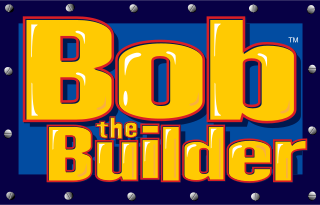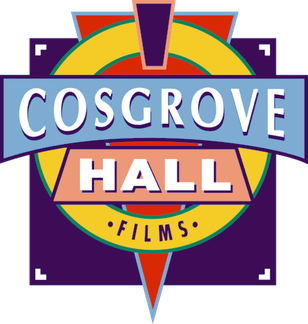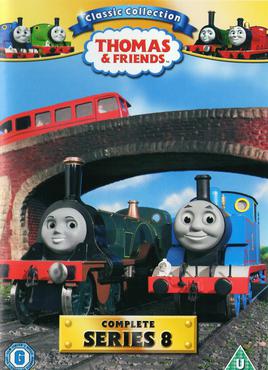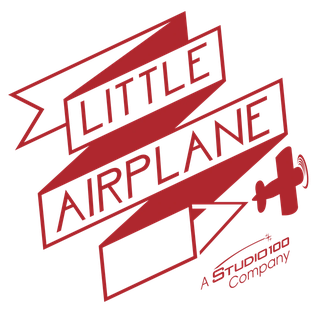
Stop motion is an animated filmmaking technique in which objects are physically manipulated in small increments between individually photographed frames so that they will appear to exhibit independent motion or change when the series of frames is played back. Any kind of object can thus be animated, but puppets with movable joints or plasticine figures are most commonly used. Puppets, models or clay figures built around an armature are used in model animation. Stop motion with live actors is often referred to as pixilation. Stop motion of flat materials such as paper, fabrics or photographs is usually called cutout animation.
Aardman Animations Limited is a British animation studio based in Bristol, England. It is known for films and television series made using stop-motion and clay animation techniques, particularly those featuring its plasticine characters from Wallace and Gromit, Shaun the Sheep, and Morph. After some experimental computer-animated short films during the late 1990s, beginning with Owzat (1997), Aardman entered the computer animation market with Flushed Away (2006). As of February 2020, it had earned $1.1 billion worldwide, with an average $135.6 million per film.

Bob the Builder is a British animated children's television series created by Keith Chapman for HIT Entertainment and Hot Animation. The series follows the adventures of Bob, a general contractor, specialising in masonry, along with his colleague Wendy, various neighbours, and friends, and equipment, and their gang of anthropomorphised work-vehicles, Scoop, Muck, Dizzy, Roley, Lofty and many others. The series ran from 12 April 1999 to 31 December 2011 in the United Kingdom through the CBBC strand and later CBeebies. The series originally used stop-motion from 1999 to 2009, but later used CGI animation starting with the spin-off series Ready, Steady, Build! (2010-2011). The British proprietors of Bob the Builder and Thomas & Friends sold the enterprise in 2011 to US toy-maker Mattel for $680 million.

Cosgrove Hall Films was a British animation studio founded by Brian Cosgrove and Mark Hall, headquartered in Chorlton-cum-Hardy, Manchester. Cosgrove Hall was a major producer of children's television and animated programmes/films, which are still seen in over eighty countries. The company was wound down by its then owner, ITV plc, on 26 October 2009. It was mainly known for its series Danger Mouse, The Wind in the Willows and Count Duckula.

HIT Entertainment Limited was a British-American entertainment company founded in 1982 as Henson International Television, the international distribution arm of The Jim Henson Company, by Jim Henson, Peter Orton, and Sophie Turner Laing. Orton alone took over the company in 1989 after learning Henson intended to sell the company to The Walt Disney Company. HIT owned and distributed children's television series such as Thomas & Friends, Fireman Sam, Bob the Builder, Pingu, Barney & Friends, and Angelina Ballerina.

Pingu is an animated children's television series co-created by Otmar Gutmann and Erika Brueggemann that first aired in Switzerland. It was produced from 1990 to 2000 by Swiss companies The Pygos Group and Pingu Filmstudio in Switzerland. It was later revived from 2003 to 2006 by British companies HIT Entertainment and HOT Animation. The series focuses on a family of anthropomorphic emperor penguins who live in the South Pole; the main character is the family's son and title character, Pingu.

Rubbadubbers is a British stop-motion children's television series produced by HIT Entertainment and HOT Animation. The series was broadcast in the UK on BBC2 and CBeebies from 2002 to 2005. Created by Peter Curtis, it focuses on seven friendly, sentient bath toys as they tell stories in imaginary worlds outside of their bathroom - the ringleader in the series being a pink frog named Tubb. In the US, the series was broadcast on Nickelodeon, Noggin and PBS Kids Sprout.

Thomas & Friends is a children's television series about the engines and other characters working on the railways of the Island of Sodor, and is based on The Railway Series books written by the Reverend W. Awdry.
Brambly Hedge is a series of illustrated children's books by Jill Barklem, recounting the adventures of a community of mice who live together in the tranquil surroundings of the English countryside. The writer described Brambly Hedge as a loving and caring society. The tales involve conflict resolution within nature or exploration, and/or the adventures of working together to achieve a common goal. There are no unkind characters or predators.

Little Airplane Productions was an American television production company co-founded by Josh Selig and Lori Shaer in 1999. The company produced Oobi for Noggin, Wonder Pets! for Nickelodeon, and 3rd & Bird for the BBC. It also released independent short films. In 2017, the company was bought by the European-based Studio 100, which entered a co-production agreement to create the comedy series Doctor Space with Little Airplane.
Cuppa Coffee Studios is a Canadian production company headquartered in Toronto, Ontario. Cuppa Coffee was founded by Adam Shaheen in 1992. It specializes in both stop-motion animation and 2D animation, winning over 150 international awards. Cuppa Coffee is currently developing live-action content through Cuppa Coffee USA.

Keith Hopwood is an English pop and rock musician, singer-songwriter, composer, businessman and record producer, who served as the rhythm guitarist and backing vocals for the 1960s pop band, Herman's Hermits. Hopwood also served as a keyboardist, singer and guitarist for the post-Peter Noone outfit, Sour Mash, which recorded an unreleased album, A Whale of a Tale for RCA.
Otmar Gutmann was a German filmmaker who specialised in animation. He co-created the stop-motion television series Pingu alongside Erika Brueggemann.
Jackie Cockle is a British stop motion animation specialist, best known as the co-founder of the HOT Animation studio, which specializes in stop motion animation. She is the creator and creative producer of the pre-school animation Timmy Time, creative producer of Bob the Builder and Brambly Hedge, director of The Wind in the Willows and more. Cockle, a graduate of the Manchester College of Art and Design, has won 3 BAFTA awards: one in the best animation category for Bob the Builder 30 minute special (2002), and two in the pre-school animation for Timmy Time - a production of the Bristol-based Aardman Animations.

Pingu in the City is an animated children's television series produced by Mattel Creations, NHK, NHK Enterprises, and Polygon Pictures. It is a reboot/continuation based on the stop-motion television series Pingu by Hit Entertainment. The series first aired on NHK Educational TV in Japan from October 7, 2017 to March 30, 2019.
Jocelyn Stevenson is a British-American writer and producer, largely for children's shows. She has received the BAFTA Special Award.

Bob the Builder, also known simply as Bob, is the titular protagonist of the British animated programme of the same name. He is a general contractor with his own construction yard in Bobsville, Sunflower Valley, Fixham Harbour, or Spring City depending on the programme.











